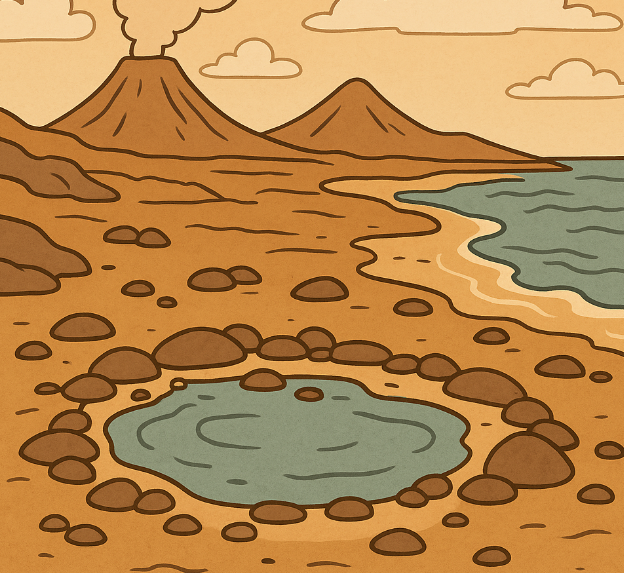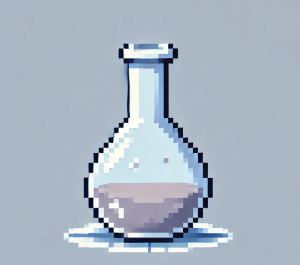
Urea Meets Life’s Building Blocks
Every living thing on Earth—bacteria, plants, humans—depends on phosphorus. It’s in our DNA, our cell membranes, even the energy molecule ATP. But here’s the puzzle: before life existed, how did phosphorus hook onto simple organic molecules to form the first steps toward life?
A new study brings us closer to the answer, and the surprising hero is a humble compound we know well today—urea. Yes, the same substance once called “the king of urine chemistry” may have fueled the leap from lifeless rocks to living cells.
From Volcanic Islands to Village Streets
Picture a rocky volcanic island billions of years ago. Pools of water fill and dry with the tides. Heat from the sun bakes the surface. No enzymes, no biology—just raw chemistry. Under those conditions, molecules like glycerol (a building block of fats) or nucleosides (pieces of RNA and DNA) had to somehow grab onto phosphate to become more complex.
It’s like trying to make bread with only flour and water—without yeast, nothing rises. Urea, the study shows, could have been nature’s yeast: the missing kickstart.
The Research Story: Cooking Life in a Dry Pan
Scientists tested twelve simple alcohols—from glycerol to nucleosides—under dry, hot conditions that mimic early Earth. Instead of watery solutions, they used “neat reactions”: heated mixtures of just the chemicals themselves, sometimes with a tiny bit of leftover water.
Temperatures ranged from 60 to 130 °C—like simmering stew on volcanic rock. The key recipe was mixing these alcohols with phosphate and urea (or its precursor, cyanamide).
Results?
- Diols and triols (molecules with 2–3 OH groups), like glycerol, are phosphorylated efficiently.
- Monools (only 1 OH group) barely reacted.
- Urea worked better than other candidate,s like formamide.
- When nucleosides were tested, many formed 2′,3′-cyclic phosphates, an important step toward RNA-like molecules
In plain terms: molecules with more “handles” grabbed phosphate more easily. Think of it like Velcro—more hooks, better grip.
The Twist: Urea as a Chemical Fuel
For years, researchers suspected urea might catalyze reactions, but this team proved something more precise. Using isotope-labeled versions of nitrogen, carbon, and oxygen, plus quantum-level computer models, they showed that urea actually breaks down into reactive fragments. These fragments form carbamoyl phosphate, which then passes phosphate onto alcohols.
This is like discovering that yeast doesn’t just sit in the dough—it actually produces the bubbles that make bread rise. Urea wasn’t just present; it was an active fuel for phosphorylation
Why It Matters Globally
The implications stretch beyond Earth’s history.
- In India, farmers know how crucial phosphate is for crops. This research suggests that the same element once “fertilized” the chemistry of life itself.
- In Nigeria, where extreme heat can dry puddles in hours, the study’s finding that “dry-hot” conditions favor life-building reactions feels strikingly familiar.
- In Brazil, where wetlands and dry seasons alternate, the idea that wet-dry cycles may not even be needed—that just heat and urea suffice—is a radical shift.
This challenges the old picture that life’s first chemistry needed constant “wet-dry” cycling. Instead, arid, hot, urea-rich spots may have been enough.
From Past to Present: A Historical Contrast
For decades, scientists imagined that life began in the ocean, deep hydrothermal vents, bubbling with minerals. Others argued for shallow ponds that dried and refilled. This study suggests a bridge: land and sea could have shared chemistry. Compounds from volcanic landmasses might have drifted into oceans, merging two worlds.
It’s a reminder that science evolves: we thought X (water was essential), but the data says Y (sometimes dry is better).
A Teaser for the Future
But here’s where it gets interesting: the experiments even produced vesicles—tiny bubbles that look like primitive cell membranes—when phosphorylated glycerol derivatives were rehydrated. That’s life’s architecture emerging spontaneously from chemistry.
And yet, not everything worked. Simple single-handle alcohols failed. Fatty acids didn’t form the way scientists hoped. The chemistry hints at winners and losers—molecules that thrived and molecules that fizzled out.
Let’s Explore Together
This study opens new doors in the story of life’s origin. But it also leaves questions:
- Could similar urea-driven chemistry happen on other planets, like Mars or Titan?
- In your lab, could you test other simple molecules under neat, hot conditions?
- In your community, what everyday problem—like food preservation, water purification, or energy storage—could benefit from insights about dry chemistry?
Science, after all, isn’t just about the past. It’s about reimagining what’s possible.



